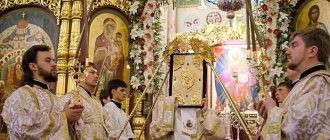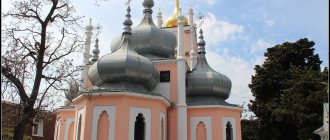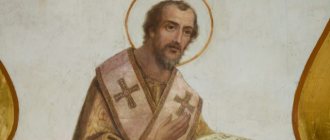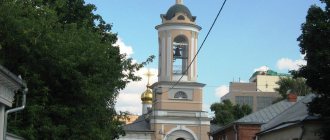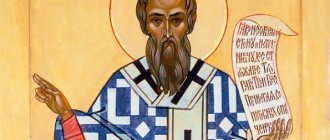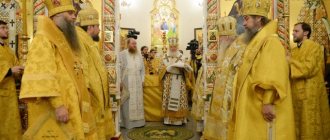INTERPRETATION OF MORNING PRAYERS
Troparion to the Cross and prayer for the fatherland
Save, O Lord, Thy people, and bless Thy inheritance, granting victories against resistance, and preserving Thy residence through Thy Cross.
Property
- property, that is, believers in Christ.
Opponents
- opponents, enemies.
Residence
- home, society, Church.
In this prayer, we ask that the Lord deliver us, Orthodox Christians, from troubles and misfortunes, grant us prosperity in life, give us the strength to defeat all violators of the peace and security of the state, and protect us with His Cross.
Translation:
Save, Lord, Your people and bless those who belong to You, helping Orthodox Christians defeat their enemies and preserving Your holy Church by the power of Your Cross.
Prayer for the living
Save, Lord, and have mercy on my spiritual father (his name)
, my parents
(names)
, my relatives according to the flesh, and all the neighbors of my family, and friends
(their names)
, and grant them Your peaceful and premium blessings.
Spiritual father
- the priest from whom you confess and whose advice you accept;
others
are friends;
peaceful
- earthly;
premium
- heavenly, unearthly, supermundane.
Translation:
Save, Lord, and have mercy on my spiritual father
(his name)
, my parents
(their names)
, my brothers and sisters, and my relatives, and all my neighbors and friends
(their names)
, and give them Your earthly and heavenly blessings.
Prayer for the departed
Rest, O Lord, the souls of Your departed servants: my parents (their names)
, relatives, benefactors
(their names)
and all Orthodox Christians, and forgive them all sins, voluntary and involuntary, and grant them the Kingdom of Heaven.
May you rest in peace
- place it in a quiet place, that is, together with the saints in an eternal blissful home.
Deceased
- fallen asleep;
this is what we call the dead whose souls, having separated from their bodies, moved from this life to another, heavenly, where they remain until the time of the general resurrection, which will be at the Second Coming of the Son of God. Free sins
are sins committed of one’s own free will;
involuntary
- against the will, due to coercion or ignorance.
Give it to them
- give it to them.
The Kingdom of Heaven
is eternal, blissful life with God.
In this prayer, we pray to God that He would place our deceased relatives, neighbors and all Orthodox Christians together with the saints in the Kingdom of Heaven, where there is no suffering, but only bliss, having forgiven them all their sins out of His ineffable mercy.
Translation:
Rest, O Lord, the souls of Your departed servants: my parents
(their names)
, relatives, benefactors
(their names)
and all Orthodox Christians, and forgive them all sins committed of their own free will and against their will, and give them the Kingdom of Heaven.
| TABLE OF CONTENTS |
1st troparion voice
Sample: Troparion to the Venerable Cross, tone 1:
O Lord, save Thy people,/ and bless Thy inheritance,/ granting victories against the enemy,// and preserving Thy life through Thy Cross.
(download)
Notes for the 1st voice: (see also notes notes).
Sunday troparion, tone 1:
The stones are sealed from the Jews / and the warriors guarding Your Most Pure Body, / You have risen on the third day, O Savior, / granting life to the world. / For this reason, for the sake of the power of heaven, we cry out to Ty, O Life-Giver: / glory to Thy resurrection, O Christ, / glory to Thy Kingdom, / glory to Thy vision, the only One who loves mankind.
Theotokos, tone 1:
To Gabriel, I spoke to You, O Virgin, rejoice,/ with a voice the Lord of all was incarnated,/ in You, the Holy Icon,/ as the righteous David said;/ you appeared, the broadest of the heavens,/ having reproached Zhidi Your body./ Glory to Him who dwells in You,/ glory to Him who passed from To You, // glory to the One who freed us through Your Christmas.
Sunday Kontakion, Tone 1:
You have risen, like God, from the grave in glory, / and you have resurrected the world with you; / and human nature, like God, sings to You, and death has disappeared; / Adam rejoices, Master; / Now we deliver Eve from bonds and he rejoices, calling // You You, O Christ, who bestow resurrection on everyone.
Troparion of St. prmts. Elizabeth.
With humility, you hid your princely dignity, / God-wise Elisabeth, / through the deep service of Martha and Mary, / you honored Christ, / with mercy, patience and love, you chose to honor yourself, / like a sacrifice you offered yourself righteous to God / But we, who honor your virtuous life and suffering, / as true We earnestly ask you to be your mentor: / Holy Martyr Grand Duchess Elizabeth, // pray to Christ God to save and enlighten our souls.
Epiphany or Epiphany of the Lord (Jan. 19) Troparion, tone 1:
In the Jordan I am baptized to Thee, O Lord,/ Trinitarian adoration appears:/ For the voice of your parents bears witness to Thee,/ naming Thy beloved Son,/ and the Spirit in the form of a dove,/ making known thy words of affirmation./ I flow into Christ God, // and enlightened world, glory to you .
Presentation of the Lord (February 15) Troparion, tone 1:
Rejoice, Blessed Virgin Mary, / from You the Sun of Truth, Christ our God, has risen, / enlightening those in darkness. / Rejoice, you too, the elder righteous, / received into the arms of the Liberator of our souls, / / yes who promises us resurrection.
Meeting of the Lord, kontakion, tone 1:
You sanctified the womb of the Maiden with Your Nativity, / and blessed the hand of Simeon, / as it was fitting, beforehand, / and now you saved us, O Christ God, / but die in battles, / and strengthen the people, / whom you loved, // the only one who loves mankind.
Entry of the Lord into Jerusalem (Sunday before Easter) Troparion, tone 1:
General Resurrection/ before Thy Passion assuring,/ Thou didst raise Lazarus from the dead, O Christ of God./ Likewise we, like the children of victory bearing the sign,/ cry out to Thee, the Conqueror of death m:/ Hosanna in the highest, // Blessed is He who comes in the name of the Lord.
Dormition of the Blessed Virgin Mary (August 28) Troparion, tone 1:
At Christmas you preserved your virginity, / in the Dormition you did not abandon the world, O Mother of God, / you reposed in the life, Mother of the Life of the Life, / and through your prayers you delivered our souls from death.
Troparion before the Iveron Icon of the Mother of God, tone 1:
From Your holy icon, O Lady Theotokos,/ healing and healing are given abundantly,/ with faith and love, to those who come to her./ So visit my weakness,/ and have mercy on my soul, O Good One , // and heal the body with Your grace, Most Pure One.
Troparion to the honest and 3 life-giving church, voice No.:
Save2 your people,/ and3 bless2 your dignity,/ victory in the resistance against the gift,// and3 yours will preserve your1st residence.
Sunday Troparion, voice No.:
The stone is sealed by the Lord,/ and 3 in 0inwm guarding your holy body,/ resurrected є3si2 three-day sp7se,/ the gift of worldly life./ today for the sake of the power of the unborn vopishu 2, life-giving: / glory to your sunrise: / glory to your glory // glory to your sight , є3di1not more extensively.
BGor0dichen, voice No.:
Gavrii1lu message to you, dv7o, rejoice, / with fear embodying everyone in Lka, / in you with kivHte, / as the speech of the right dv7d:/ kvi1lasz є3si2 shi1rshaz nb7s,/ vilified zizh and1bodyz of yours2./ glory to all musz in tS:/ glory to the past and3z8 to you // glory to the one who freed us.
Kontakion, Sunday, voice No.:
Voskrl є3сi2 ћкw bGъ и3з8 gr0ba in glory,/ и3 mjръ совскRсi1лъ є3сi2,/ and3 є3nature2 human ћкw bGа sings tS, and3 death and3disappeared:/ ґdam will rejoice in Lko,/ є 4va nhne t ќз єззъвлшема rejoicesz calling // you2 є3сi2, and 4 all Serve Sunday.
Troparion of the Holy Martyr E#3lisavete, voice no.:
Let us humble the dignity of the princely abbreviation, / by Gomydraz є3lisaveto, / by the deep service of Marfa and 3 Marji / Khrta almost 1la є3si2. / mercy, patience and3 self-love, / ћkw sacrifice of righteousness was brought by є3с2. / mh, honor the virtuous life and3 suffering of yours, / ћкw and4 true mentor ўserdnw ўserdnw pm tS: / ™az m§nce great book є3lisaveto, // pray2 xrta bGa sp7sti2 and3 enlightenment1 these are our souls.
BGozvlenіe gDne. Troparion of the holiday, voice No.:
In the Jordan I baptize you, gDi,/ trbbkvi1sz worship:/ the parents' voice bears witness to you,/ beloved tS sn7a and 3menyz,/ and 3 d¦b in the sight of the dove,/ and your word is confirmed no./ Kvleisz xrte b9e,// and 3 world of enlightenment, glory to you.
Candlemas is not. Troparion of the holiday, voice No.:
Rejoice, thanks be to you, / and from you1 for the sun of truth is ours, / the enlightened being in this: / cheerful1sz and3 you2, the elder righteous, / accepted into the world of freedoms and 1 bodies of our souls, // giving us resurrection.
Candlemas is not. Kontakion of the holiday, voice No.:
Otr0bu dv7i1chu њsvzzti1vyj њсвзтв0м your1m, / and 3 rytse smmeHne bliss1vyy, / as befitting, pred1v / and 3 nhne saved є3si2 us, xrte b9e:/ but ўpeace2 in the battle of life / and3 ўkrepi2 people,/ and4xe loved є3si2,// є3di1ne more lov11b more.
Entrance to the city. Troparion of the holiday, voice No.:
General Sunday, / first of all, / and 3 from 8 the dead raised є3si2 lazarz хрте b9е./ also and 3 we2 ћкw џtroyers of victory will be celebrated, / to you, the conqueror of death, von Iem:/ Sanna is in the Lord, // Blessed is the world in the world.
Ospenie pres™hz btsdy. Troparion of the holiday, voice No.:
During the reign, she preserved her virginity, / in the Dormition of the world, she did not leave her, btsde, / she transferred her to the belly, m™i of the belly // and 3 with your prayers and 3 spared the death of our souls.
Iverskіz їкны pres™hz btsdy, troparion, voice no.:
T s™hz їкНня is yours, q in Lchce btsde,/ and3 celba1niz and3 celby6 I give1tsz nbi1lnw,/ with faith and3 love coming to her:/ sow and3 my2 infirmity sat2,/ and3 my soul2 have mercy, blgaz , // and 3 the body was healed 2 with your grace, prechctaz.
Author: Administrator
Publication date: 11/12/2018
Responses (375)
You must be logged in to leave a response.
“And Thine preserving residence by Thy Cross,” - On the Feast of the Exaltation of the Cross of the Lord
The great Moscow Metropolitan of the 19th century, in his sermon, reminded his listeners of how voluntary the suffering of the God-Man was, who with one wave of his finger could destroy the plan of the tormentors and avoid bonds and suffering, but He Himself wanted to endure torment, reproach and death for the sake of the redemption of humanity.
The Savior sprinkled the cross, the most shameful and painful of the Roman instruments of execution, with his most pure blood, after which this symbol of suffering radically changed its meaning. From a sign of despondency and death, the cross became a sign of eternal life and hope for the Kingdom of Heaven. From an extremely shameful instrument - an emblem of glory and honor, so that even most of today's awards are based on the symbol of the cross.
That is why the Church so reveres the instruments of the Passion of Christ and, in particular, the Holy and Life-giving Cross of the Savior and especially honors the day when the Holy Cross was rediscovered by Christians after many centuries of oblivion.
The story of finding the Holy Cross
After the destruction of Jerusalem, which followed the uprising of the Zealots in the first half of the 2nd century, Emperor Hadrian ordered Calvary, the Holy Sepulcher and all the relics found there to be covered with earth, and on an artificial hill he erected the temple of the pagan goddess Venus, the sanctuary of Aphrodite and the statue of Jupiter, where the pagans gathered to perform sacrifices to idols.
In the 4th century, Emperor Constantine the Great, under the influence of his mother, Queen Helena, converted to Christianity himself and made it the state religion of the Roman Empire. In 326, the Holy Equal-to-the-Apostles Empress Helen undertook a pilgrimage to the Holy Land to search for lost Christian relics there.
This is where the legends differ. The more ancient of them says that Queen Helena and Bishop Macarius of Jerusalem knew from early Christians that the instruments of the Passion of Christ after the execution of the Savior were thrown into a hole very close to Golgotha and ordered to dig up the entire mountain. In one place they were hindered by a pagan temple, which was destroyed by order of the queen. It was in its ruins that three crosses were found (of the Lord and of both thieves crucified with him).
To determine which of the crosses belonged to the Savior, they were placed one by one on the coffin of the deceased person, whom relatives were carrying past to the cemetery at that time. When the Holy Cross of the Lord was laid on the tomb, the dead was resurrected. That is why the Holy Cross is called the Life-Giving Cross.
According to a later, but also more widespread version, which is read in the prologue on the day of the Exaltation of the Cross, the old Jew Judas (not without coercion) showed Equal-to-the-Apostles Helen the place under the temple of Aphrodite, where, according to the testimony of his ancestors, holy relics were hidden, and the queen found them in a garbage pit The Holy Cross of Christ and most of the other instruments of the Passion of the Lord - title, nails, crown of thorns, etc.
The shrines were prayerfully cleansed of dirt, and the sick woman nearby, who fell to the Cross with tears, received healing from a serious illness. So they realized that the shrines were true, and the Jew Judas was baptized with the name Cyriacus (from the Greek “Lord’s”) and over time even became the Bishop of Jerusalem.
The queen was accompanied by hundreds of believers, and after the discovery of the Holy Cross, reverent worship of the Cross and kissing of it began, but due to the crowds, many could not get closer or even see it. Then the Patriarch of Jerusalem Macarius showed the found Cross to the people from a high place, which served as a tradition to erect (raise) the cross for worship on the day of the holiday.
The Holy Cross of Christ was divided by the holy queen into several parts so that as many believers as possible could venerate the great shrine. Most of it was taken by Saint Helena to Constantinople (according to other sources, to Rome, where it was kept at her palace, and after that it ended up in Constantinople). The second large part of the Cross, like several other instruments of the Passion of the Lord, remained in Jerusalem. The third share of the shrine was sent to Rome.
Several small particles of the shrine were transported to different cities around the world. Moreover, as many sources note (for example, Saints Gregory of Nyssa and John Chrysostom), small particles of the Holy Cross could be found not only in city churches and remote monasteries, but also in the pectoral relics of many Christians.
On the canonical territory of the Russian Orthodox Church today you can find particles of the Holy Cross of the Lord in several cities at once. Such a great shrine is in the Ascension Cathedral of the city of Novosibirsk, the Trinity-Sergius Lavra, the Annunciation Cathedral of the Moscow Kremlin, the Holy Dormition Pochaev Lavra and other churches and monasteries.
Holy Queen Helena did not stay long in Jerusalem, but during this time she managed to erect up to 80 churches at Golgotha, Bethlehem, Tabor, Gethsemane and other memorable places associated with the earthly life of the Lord Jesus Christ.
Establishment of celebration in the Church
By the end of the 4th century, the Church of Jerusalem especially solemnly celebrated three Christian holidays - the Resurrection of Christ, the Nativity of Christ and the Feast of the Renewal of the Basilica of the Martyrium and the Rotunda of the Resurrection (temples that were built by order of Queen Helena on Golgotha and other holy places).
At the same time, the Feast of the Exaltation of the Cross was also celebrated, which initially occupied a secondary significance in relation to the Feast of the Renewal of the Jerusalem Temples. According to the “Easter Chronicle” of the 7th century, the sacred rite of the Exaltation (Greek “staurofaneia” - “the appearance of the Cross” to believers) was first performed during the festivities during the consecration of Jerusalem churches.
The existence of the local tradition of the Exaltation of the Cross at this time is also evidenced in her memoirs by the famous 4th century pilgrim Eteria (Sylvia of Aquitaine).
Starting from the 6th century, the Exaltation of the Cross gradually became an increasingly significant holiday, and the holiday of the Renewal of the Churches faded into the background, until by the end of the 7th century the Exaltation of the Cross acquired the modern status of the Twelfth Feast and spread to the rest of the Local Churches.
A new understanding of the Exaltation of the Cross also occurred in connection with the capture of Jerusalem by the Persians in 614, during which many temples and shrines were destroyed, and the Holy Cross (that part of it that was kept in Jerusalem) and the Patriarch of Jerusalem were captured by the Persians and taken away with them.
It was possible to recapture the shrine and its Primate only a decade and a half later, during the reign of the Byzantine Emperor Heraclius. In 628, the Holy Cross solemnly returned to the Church of the Resurrection of Christ. Since then, on the day of the Exaltation of the Precious and Life-Giving Cross of the Lord, both of these events are remembered - the discovery of the Cross and its return from captivity of the pagans.
Traditions and features of the Exaltation of the Cross
The Church celebrates the Exaltation of the Cross of the Lord on September 14 (September 27 according to the new style). This holiday has one day of pre-feast and seven days of post-feast.
The services of this Twelfth Feast are performed by the clergy in vestments of violet (purple) color. In memory of the sufferings of the Lord Jesus Christ on the cross on the day of the holiday, the Church prescribed strict fasting.
On the eve of the holiday, an all-night vigil is held. At the small vespers of the vigil, the Cross is transferred from the altar to the altar (in parish churches, the Cross is often immediately placed on the altar before the start of the service, and the Gospel is placed behind the antimension).
There is no anointing at Matins, the Gospel is read at the altar, and after the reading of the Gospel, “Having seen the Resurrection of Christ” is always sung, even if the celebration does not fall on a Sunday.
During the Great Doxology, while singing the Trisagion, the priest in full vestments carries the cross to the middle of the church and places it on the lectern. Then the troparion “We worship Thy Cross, O Lord...” is chanted three times, during which prostrations are made three times.
Then special stichera are sung, during which the priest anoints with oil, and then the special litany, the usual end of the all-night vigil and the first hour.
The canon depicts the power of the Cross, revealed in the Old Testament prototypes of the cross (Moses, who raised his hands in a cross shape during the battle and thereby begged for victory; the tree that sweetened the waters of Marah, etc.), and in the New Testament miracles
At the Liturgy (instead of the “Trisagion” and without prostrations), the troparion “We worship Thy Cross, Master...” is sung again. The Apostle says (I Cor., I, 18–24) that the Cross and the sufferings of the Savior represent God’s power and God’s Wisdom, and in the Gospel of John (XIX, 6–11, 13–20, 25–28, 30 –35) contains the story of the sufferings of the God-man.
The cross lies on the lectern in the middle of the temple until September 21, the day of the Exaltation. At the end of the liturgy, the troparion and kontakion are sung to the Holy Cross, and then it is carried by the priest to the altar through the Royal Doors.
In Rus', during the days of the Exaltation of the Cross, it was customary to build chapels and small churches, as well as to install worship crosses (by vow, along roads, on the site of churches under construction and in gratitude for God’s help).
Interesting Facts
According to a number of researchers, the Feast of Renewal (and the Exaltation of the Cross) became the Christian analogue of the Old Testament Feast of Tabernacles, one of the 3 main holidays of Old Testament worship. This is precisely the reason for the choice of the date of celebration - September 14.
On the icons of the Exaltation of the Cross, not only Patriarch Macarius and the Holy Queen Helen are almost always present holding the Holy Cross on a dais, but also the Holy Emperor Constantine the Great (despite the fact that he was not in the Holy Land at that time). Thus, the very possibility of acquiring the greatest shrine is associated by the Church with the legalization and support of Christianity by the holy emperor.
Popularly, on this day, peasants painted crosses on the doors of their houses and placed small wooden crosses in the mangers of cows and horses. If there was no cross, it was replaced by crossed rowan branches.
Andrey Szegeda
You can applaud the author (at least 10 times)27

